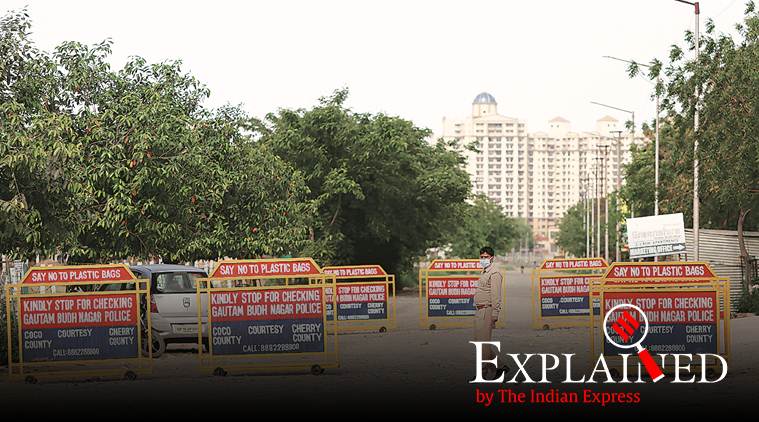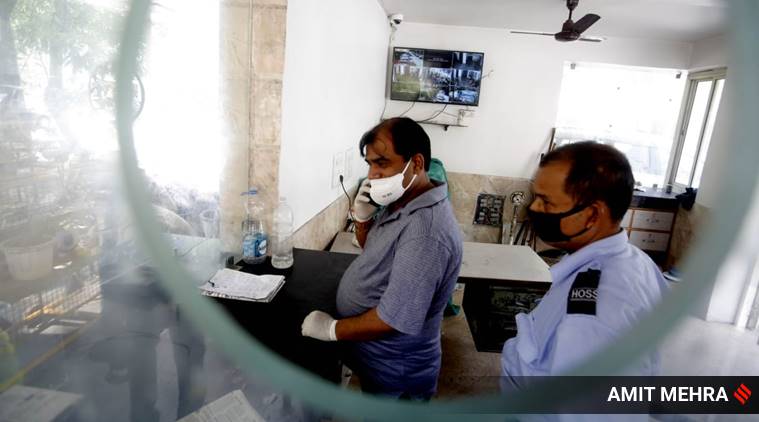The sealing of COVID-19 hotspots is part of the government’s larger plan to contain the spread. A look at the approach laid down, stage by stage, and what is recommended on hospitalisation and treatment.
In the last couple of days, several areas in the National Capital Region have been cordoned off — “sealed” — to try and restrict the novel coronavirus disease (COVID-19) within that area. This is part of India’s “containment” plan, essentially an updated version of an earlier Health Ministry blueprint that was drawn up when the only COVID-19 cases were those coming from abroad.
What are the components of the plan?
The plan outlines a strategic approach based on the stage of transmission. Five stages have been identified — travel-related case reported in India; local transmission; large outbreaks amenable to containment; widespread community transmission; India becoming endemic for COVID-19.
“At the time of writing this document, many of the crucial epidemiological information particularly source of infection, mode of transmission, period of infectivity, etc are still under investigation,” reads a disclaimer. Officials say it means that the plan is subject to revisions if required, as and when there is greater clarity about some of these aspects.
What is the approach recommended for the various stages?
Containment of local transmission hinges on extensive contact tracing and search for cases in the containment zone, testing all suspect cases and high-risk contacts, and isolating all suspect or confirmed cases; quarantining contacts; and social distancing.
For larger outbreaks, in addition to the usual measures, there is higher focus on a particular geographic zone and hospitals around the area are prepared for a rise in cases. This was done in Agra in early March when the area was cordoned off, contact tracing and isolation undertaken at a large scale in Lohamandi area, and S N Hospital became the base of the surveillance team and also the place where suspected cases could be taken if required. In addition, all asymptomatic healthcare workers are to be given hydroxychloroquine as a preventive.
The graded containment plan in effect takes lessons from the H1N1 influenza pandemic where the spread was in clusters. “The current geographic distribution of COVID-19 mimics the distribution of H1N1 Pandemic Influenza. This suggests that while the spread of COVID-19 in our population could be high, it’s unlikely that it will be uniformly affecting all parts of the country. This calls for differential approach to different regions of the country, while mounting a strong containment effort in hot spots,” reads the plan document.
How are confirmed and suspected cases to be dealt with?
It says: “All suspect/confirmed COVID-19 cases will be hospitalized and kept in isolation in dedicated COVID-19 hospitals/hospital blocks. Persons testing positive for COVID-19 will remain hospitalized till such time as two of their samples are tested negative as per discharge policy. About 15% of the patients are likely to require hospitalization, and an additional 5 % will requires ventilator management.”
To reduce the burden on hospitals, there is a plan to temporarily convert hotels/ hostels/ guesthouses/ stadiums near a COVID-19 hospital as care centres where mild cases may be kept. “Dedicated COVID-19 hospitals/dedicated blocks in large hospitals will be identified and operationalized. Moderate to severe cases, who require monitoring of their clinical status (patients with radiological evidence of pneumonia) will be admitted to COVID hospital.” For more severe cases requiring respiratory or other support, tertiary care centres both private and government will be included as part of the micro plan.
So, the protocol varies based on severity?
Yes. The Health Ministry has issued directions for categorisation of designated facilities into three groups — COVID care centres, COVID health centres and dedicated COVID hospitals. The care centres will be for cases clinically assigned as mild or very mild, or suspected cases. The health centres are hospitals that will offer care for all cases that have been clinically assigned as moderate. The dedicated hospitals will offer comprehensive care, primarily for those clinically assigned as severe.
“The COVID care centres are makeshift facilities. These may be set up in hostels, hotels, schools, stadiums, lodges etc., both public and private.(COVID health centres) should either be a full hospital or a separate block in a hospital with preferably separate entry/ exit/ zoning.(they) will have separate areas for suspect and confirmed cases. Suspect and confirmed cases should not be allowed to mix under any circumstances,” said the document on categorisation of care and hospitalisation facilities prepared by the emergency medical response division of the Health Ministry.
What is the line of treatment?
The document collates the various advisories issued by the Indian Council of Medical Research (ICMR), emphasising that till now there is no approved specific drug or vaccine against COVID-19.
“However Hydroxychloroquine has been recommended as chemoprophylaxis drug for use by asymptomatic healthcare workers managing COVID-19 cases and asymptomatic contacts of confirmed COVID-19 cases… In addition a combination of Hydroxychloroquine and Azithromycin has been advocated for use in severe cases of COVID-19 under medical supervision,” it says. On Thursday, the ICMR said it is in the final stages of preparing a clinical trial protocol for convalescent plasma therapy.
Does it address the concerns of healthcare personnel?
Amid unrest among medical personnel across the country over the availability and quality of personal protective equipment (PPE), the plan reiterates the need for adequate PPE. “At all times doctors, nurses and para-medics working in the clinical areas will wear three-layered surgical mask and gloves. The medical personnel working in isolation and critical care facilities where aerozolisation is anticipated, will wear full complement of PPE (including N95 masks).The support staff engaged in cleaning and disinfection will also wear full complement of PPE. Environmental cleaning should be done twice daily and consist of damp dusting and floor mopping with Lysol or other phenolic disinfectants and cleaning of commonly touched surfaces with sodium hypochlorite solution,” says the document. Sodium hypochlorite is already being used extensively, including in the Nizamuddin headquarters of the Tablighi Jamaat.
Here’s a quick Coronavirus guide from Express Explained to keep you updated: What can cause a COVID-19 patient to relapse after recovery? | COVID-19 lockdown has cleaned up the air, but this may not be good news. Here’s why | Can alternative medicine work against the coronavirus? | A five-minute test for COVID-19 has been readied, India may get it too | How India is building up defence during lockdown | Why only a fraction of those with coronavirus suffer acutely | How do healthcare workers protect themselves from getting infected? | What does it take to set up isolation wards?
? The Indian Express is now on Telegram. Click here to join our channel (@indianexpress) and stay updated with the latest headlines
For all the latest Explained News, download Indian Express App.
Source: Read Full Article







